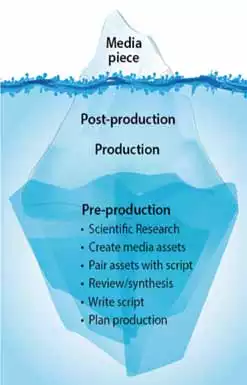In the Trenches - January 2015
Volume 5, Number 1
In This Issue
- Establishing an Elementary Foundation for Teaching Global Change - Mark S. McCaffrey, National Center for Science Education
- The CAM Project: Tools for Bringing Student Media Production into Climate Change Education - Juliette N. Rooney-Varga, University of Massachusetts-Lowell; Angelica Allende Brisk, Cambridge Media Arts Studio; Mitch Schuldman, University of Massachusetts-Lowell; and Kenneth Rath, SageFox Consulting Group
- Resources to Prepare Student for Climate Change - Cindy Shellito, Editor-in-Chief
- Engaging Students Before, During, and After Visits to Informal Science Education Centers - Laura A. Guertin, Penn State Brandywine
- Diving into the Trenches: Rules of Thumb for Teaching Controversial Issues - Don Haas, Paleontological Research Institution
 ×
Establishing an Elementary Foundation for Teaching Global Change
×
Establishing an Elementary Foundation for Teaching Global Change

Mark S. McCaffrey, National Center for Science Education
- Framework for K-12 Science Education: Practices,Crosscutting Concepts, and Core Ideas
- Climate Change 2013: The Physical Science Basis. Contribution of Working Group I to the Fifth Assessment Report of the Intergovernmental Panel on Climate Change
 ×
The CAM Project: Tools for Bringing Student Media Production into Climate Change Education
×
The CAM Project: Tools for Bringing Student Media Production into Climate Change Education

Juliette N. Rooney-Varga, University of Massachusetts-Lowell; Angelica Allende Brisk, Cambridge Media Arts Studio; Mitch Schuldman, University of Massachusetts-Lowell; and Kenneth Rath, SageFox Consulting Group
- Climate Education in an Age of Media (CAM) Project
- The Psychology of Climate Change Communication: A Guide for Scientists, Journalists, Educators, Political Aides, and the Interested Public
- Yes We CAM: Youth Media for Climate Awareness
- Teens and Online Video
Resources to Prepare Student for Climate Change
Cindy Shellito, Editor-in-Chief
- Climate Literacy and Energy Awareness Network
- Earthlabs
- Interdisciplinary Teaching about Earth for a Sustainable Future (InTeGrate)
- The National Oceanic and Atmospheric Administration/NOAA
- NOAA's National Climate Data Center
- NASA's Global Climate Change website
- NASA's Eyes on the Solar System
- Yale Project on Climate Change Communication
- The Climate Voices Science Speakers Network
- The Union of Concerned Scientists Global Warming
- Realclimate.org
 ×
Engaging Students Before, During, and After Visits to Informal Science Education Centers
×
Engaging Students Before, During, and After Visits to Informal Science Education Centers

Laura M. Guertin, Penn State Brandywine
- Learning Science in Informal Environments
- NSTA Position Statement: Learning Science in Informal Environments
 ×
Diving into the Trenches: Rules of Thumb for Teaching Controversial Issues
×
Diving into the Trenches: Rules of Thumb for Teaching Controversial Issues

Don Haas, Paleontological Research Institution
- For a full transcript of the presentation upon which this is based, presented in October 2014 at the Geological Society of America Annual Meeting, see: http://bit.ly/controversy2014.
Web Features
Climate Education in an Age of Media (CAM) Project »
CAM engages students in the educational process by involving them in the creation of short films, animations, and video journalism related to climate change, integrating science with media literacy in ways that are readily adopted in a range of instructional environments.
Interdisciplinary Teaching about Earth for a Sustainable Future (InTeGrate) »
This is a community effort to improve geoscience literacy and build a workforce that is prepared to tackle societal issues. This 5 year project is a NSF STEP center grant and runs from 2012 through 2016, with many pathways for faculty involvement and collaboration.
Climate Literacy and Energy Awareness Network (CLEAN) »
The CLEAN project, a part of the National Science Digital Library, provides a reviewed collection of resources coupled with the tools to enable an online community to share and discuss teaching about climate and energy science.
Earthlabs »
EarthLabs is an effort to develop a rigorous high school Earth science lab course. Several of the modules present a series of climate labs that address weather and climate not simply as atmospheric processes, but in the context of the interconnected Earth system, which includes the planet's oceans, landmasses, biosphere, and cryosphere (Earth's frozen places), as well as the atmosphere.
Site Guide: Climate Change and Global Warming »
Find resources and teaching materials such as activities, course descriptions, visualizations, and effective teaching methods from SERC projects and collaborators for teaching about climate, climate change, and sustainability across the curriculum.
News and Advertisements
View All Website News Releases- Registration is Now Open for the Earth Educators' Rendezvous
- Scholarships for Field Study
- Implementing the Next Generation Science Standards
- Kelley Named US Professor of the Year
- UNAVCO Geo-LAUNCHPAD Internships
- Lamont Summer Intern Program
Community Advertisements
- Two-Year Visiting Position in Paleontology/Sedimentary Geology - Cornell College
- Semester Position in Paleoclimatology - Cornell College
- Assistant Professor of Geology - University of Mississippi
- Assistant Professor, Field Geologist in Stratigraphy/Sedimentology or Igneous/Metamorphic Petrology - Angelo State University
back to top

